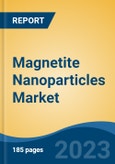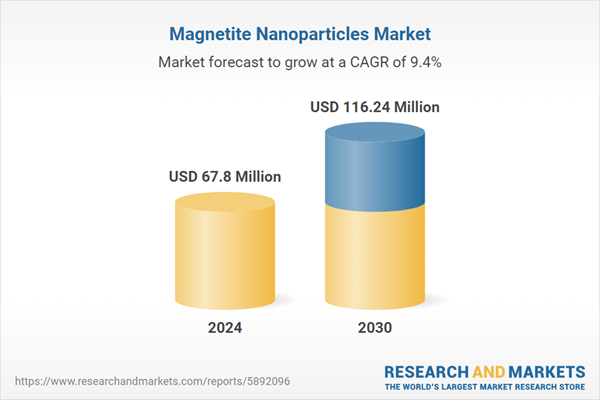Speak directly to the analyst to clarify any post sales queries you may have.
10% Free customizationThis report comes with 10% free customization, enabling you to add data that meets your specific business needs.
Key Market Drivers
Rising Demand of Magnetite Nanoparticles in Bio-medical Sector
The rising demand for magnetite nanoparticles in the biomedical sector is a primary driver of growth in the Global Magnetite Nanoparticles Market, significantly shaping its expansion and commercial potential. This surge is fueled by the convergence of advanced nanotechnology, increasing healthcare needs, and growing investments in precision medicine. Magnetite nanoparticles, known for their unique magnetic properties, biocompatibility, and functional versatility, are revolutionizing multiple biomedical applications, thereby accelerating global market growth.Magnetite nanoparticles are at the forefront of targeted drug delivery systems, enabling precise transport of therapeutic agents to specific sites within the body using external magnetic fields. This innovation enhances treatment efficacy while minimizing systemic toxicity and side effects. With the increasing prevalence of chronic diseases such as cancer, cardiovascular disorders, and neurodegenerative conditions, the demand for targeted, controlled, and efficient drug delivery platforms has soared driving rapid adoption of magnetite nanoparticles in pharmaceutical and biotech industries. In the diagnostic space, magnetite nanoparticles are increasingly used as contrast agents in Magnetic Resonance Imaging (MRI). Their superparamagnetic properties enable superior image contrast and resolution compared to traditional agents. As the global diagnostic imaging market continues to grow driven by aging populations, higher diagnostic screening rates, and a focus on early disease detection the demand for high-performance, safe, and efficient contrast materials is steadily rising, creating robust opportunities for magnetite nanoparticle manufacturers.
Magnetite nanoparticles play a pivotal role in magnetic hyperthermia therapy, a minimally invasive treatment that uses localized heating to destroy cancer cells. The nanoparticles are guided to tumor sites and exposed to alternating magnetic fields to generate heat. This method is gaining traction for its ability to complement chemotherapy and radiation, especially in hard-to-treat cancers.
As clinical trials and research initiatives validate its effectiveness, the demand for magnetite nanoparticles in oncological applications is projected to grow exponentially. Magnetite nanoparticles are increasingly being integrated into tissue engineering, biosensors, and gene delivery systems, expanding their role in regenerative medicine and diagnostics. Their functional surfaces can be customized with biomolecules for enhanced targeting, signal transduction, or cellular interaction. These applications are critical to the development of next-generation medical technologies, further propelling market growth.
Key Market Challenges
Scalability & Reproducibility and Surface Functionalization & Specificity
The production of magnetite nanoparticles on a large scale while maintaining their desired properties is a challenge that hinders their widespread commercialization. Ensuring reproducibility the ability to consistently obtain nanoparticles with the same characteristics is crucial for industries that rely on uniform materials for their products. Overcoming this challenge requires refining synthesis methods, optimizing parameters, and establishing quality control protocols to achieve consistent results in manufacturing.Moreover, in biomedical and environmental applications, the surface properties of magnetite nanoparticles play a crucial role in interactions with target molecules or cells. Achieving precise and controlled surface functionalization is a challenge, as it involves attaching specific molecules to the nanoparticle surface to confer desired properties such as targeting capabilities, biocompatibility, or catalytic activity. Developing methods to effectively functionalize nanoparticle surfaces while retaining their stability and performance is a significant challenge in realizing their full potential.
Key Market Trends
Unveiling the Potential
Magnetite nanoparticles, also known as superparamagnetic iron oxide nanoparticles (SPIONs), possess magnetic properties that are distinct at the nanoscale. Unlike their bulk counterparts, these nanoparticles exhibit superparamagnetic, a phenomenon that sparks interest in scientists and engineers due to its potential applications. The versatility of magnetite nanoparticles arises from their size-dependent properties and the ease of tuning their surface chemistry, enabling tailored functionalities for specific uses.Moreover, one of the most prominent trends driving the magnetite nanoparticles market is their flourishing role in the biomedical field. These nanoparticles are gaining traction for their remarkable potential in diagnostics, imaging, drug delivery, and even therapeutic applications. In diagnostics, they serve as contrast agents for advanced imaging techniques such as magnetic resonance imaging (MRI), allowing for enhanced visualization of specific body tissues and structures. Moreover, they are employed in targeted drug delivery systems, ensuring precise drug release at the intended site and minimizing unwanted side effects.
Key Market Players
- Ascensus Specialties LLC
- American Elements
- US Research Nanomaterials, Inc.
- Nanoshel LLC
- Merck KGaA
- Nanocomposix, Inc.
- Reade International Corp.
- Cytodiagnostics inc.
- SkySpring Nanomaterials, Inc.
- Nanografi Nano Technology
Report Scope:
In this report, the Global Magnetite Nanoparticles Market has been segmented into the following categories, in addition to the industry trends which have also been detailed below:Magnetite Nanoparticles Market, By Application:
- Bio-medical
- Electronics
- Water Treatment
- Others
Magnetite Nanoparticles Market, By Region:
- North America
- United States
- Canada
- Mexico
- Europe
- France
- Germany
- United Kingdom
- Italy
- Spain
- Asia-Pacific
- China
- India
- South Korea
- Japan
- Australia
- South America
- Brazil
- Argentina
- Colombia
- Middle East & Africa
- South Africa
- Saudi Arabia
- UAE
Competitive Landscape
Company Profiles: Detailed analysis of the major companies present in the Global Magnetite Nanoparticles Market.Available Customizations:
With the given market data, the publisher offers customizations according to a company's specific needs. The following customization options are available for the report.Company Information
- Detailed analysis and profiling of additional market players (up to five).
Table of Contents
Companies Mentioned
- Ascensus Specialties LLC
- American Elements
- US Research Nanomaterials, Inc.
- Nanoshel LLC
- Merck KGaA
- Nanocomposix, Inc.
- Reade International Corp.
- Cytodiagnostics inc.
- SkySpring Nanomaterials, Inc.
- Nanografi Nano Technology
Table Information
| Report Attribute | Details |
|---|---|
| No. of Pages | 180 |
| Published | August 2025 |
| Forecast Period | 2024 - 2030 |
| Estimated Market Value ( USD | $ 67.8 Million |
| Forecasted Market Value ( USD | $ 116.24 Million |
| Compound Annual Growth Rate | 9.4% |
| Regions Covered | Global |
| No. of Companies Mentioned | 10 |









